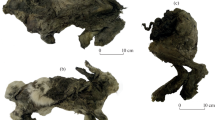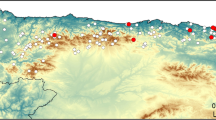Abstract
Six different mosses have been recognised in samples taken from the intestinal contents of the 5,200-year-old Iceman from the Eastern Alps. Four of the species are important in understanding the lifestyle of the man and/or bear on the events during the last few days of his life: Anomodon viticulosus, Hymenostylium recurvirostrum, Neckera complanata and Sphagnum imbricatum. The past and present chorology and habitats of the Hymenostylium are discussed in detail, as is the ethnobotany of the Sphagnum concerning both the Iceman and Kwäday Dän Ts’ìnchí, the first ancient glacier body from North America.






Similar content being viewed by others
References
Bates JW (1998) Is “life-form” a useful concept in bryophyte ecology? Oikos 82:223–237
Blockeel TL (1992) In: Hill MO, Preston CD, Smith AJE (eds) Atlas of Bryophytes, vol 2. Harley Books, Colchester
Buchner A, Hofbauer W, Gärtner G (1993) Contribution to the Bryophye Flora Seefeld and Leutasch (Northern Tyrol). Ber nat.med Verein Innsbruck 80:53–67
Cortini Pedrotti C (2001) Flora dei muschi d’Italia. Sphagnopsida, Andreaeopsida, Bryopsida (I Parte). Atonia Delfino, Roma
Crum HA, Anderson LE (1981) Mosses of Eastern North America. Columbia University Press, New York
Dalla Torre KW, Sarnthein LG (1904) Die Moose (Bryophyta) von Tirol, Vorarlberg und Liechtenstein. Wagner’schen Universitäts Buchhandlung, Innsbruck
Dickson C, Dickson JH (2000) Plants & People in Ancient Scotland. Tempus, Stroud
Dickson JH (1973) Bryophytes of the Pleistocene. Cambridge University Press, Cambridge
Dickson JH (1986) Bryophyte analysis. In: Berglund BE (ed) Handbook of Holocene Palaeoecology and Palaeohydrology. Wiley, Chichester
Dickson JH (1997) The moss from the Tyrolean Iceman’s colon. J Bryol 19:449–451
Dickson JH (2000) Bryology and the Iceman: chorology, ecology and ethnobotany of the mosses Neckera complanata Hedw. and Neckera crispa Hedw. In: Bortenschlager S, Oeggl K (eds) The Iceman and his natural environment. The man in the Ice, vol 4. Springer, Wien, pp 77–88
Dickson JH (2003) Low to moderate altitude bryophytes at the Iceman site and their significance. Schr Südtiroler Archäologiemuseums 3:27–34
Dickson JH, Bortenschlager S, Oeggl K, Porley R, McMullen A (1996) Mosses and the Tyrolean Iceman’s Southern Provenance. Proc Roy Soc Lond B 263:567–571
Dickson JH, Oeggl K, Holden T, Handley LL, O’Connell T, Preston T (2000) The omnivorous Tyrolean Iceman: colon contents (meat, cereals, pollen, moss and whipworm) and stable isotope analyses. Phil Trans Roy Soc Lond 355:1843–1851
Dickson JH, Richards MP, Hebda RJ, Mudie PJ, Beattie O, Ramsay S, Turner NJ, Leighton BJ, Webster JM, Hobischak NR, Anderson GS, Troffe PM, Wigen RJ (2004) Kwäday Dän Ts’ìnchí, the first ancient body of a man from a North American glacier: reconstructing his last days by intestinal and biomolecular analyses. Holocene 14:481–486
Dickson JH, Hofbauer W, Kofler W, Oeggl K, Platzgummer J (2005a) How to find the bogmoss, Sphagnum imbricatum s.l., in the South Tyrol, Italy: Microscopically examine the Iceman’s colon contents. Veget Hist Archaeobot 14:207–210
Dickson JH, Oeggl K, Handley LL (2005b) The Iceman reconsidered. Sci Am 15:4–13
Dierssen K (2001) Distribution, ecological and phytosociological characterization of European bryophytes. Bryophyt Biblio 56:1–289
Düll R (1991) Die Moos Tirols unter Berücksichtigung des Pitztales/Öztaler Alpen. IDH-Verlag, Bad Münstereifel
Düll R, Meinunger L (1989) Deutschlands Moose. Bad Münstereifel, IDH-Verlag
Egg M, Goedecker-Ciolek R, Groeman van Waateringe W, Spindler K (1993) Die Gletschermumie vom Ende der Steinzeit aus den Ötztaler Alpen. Jahrb Röm-Germ Zentralmus Mainz 39:1–128
Gostner P, Egarter Vigl E (2002) INSIGHT: report of radiological-forensic findings on the Iceman. J Archaeol Sci 29:323–326
Grims F (1999) The mosses of Austria. Catalogus Florae Austriae, Part II. Bryophyta No 1. Musci. Austrian Academy of Sciences, Vienna
Hill MO, Preston CD Smith AJE (1992) Atlas of the Bryophytes of Britain and Ireland. Harley Books, Colchester
Holmen K (1960) The Mosses of Peary Land, North Greenland. Medd Grǿn 163:1–96
Johnson LM, Vitt DH (1996) The selection of sphagnum for diapers by indigenous North Americans. Evansia 13:103–108
Magny M, Haas J-N (2004) A major widespread climatic change around 5300 ca. yr BP at the time of the Alpine Iceman. J Quat Sci 19:423–430
Magny M, Leuzinger U, Bortenschlager S, Hass JN (2005) Tripartitie climatic reversal in Central Europe 5600–5300 years ago at Arbon-Bleiche, Switzerland. Quat Res 65:3–19
Mårtensson O (1956) Bryophyes of the Torneträsk Area, Northern Swedish Lappland II Musci. Kungl Svenska Avh i Naturv 14:1–321
Mudie PJ, Greer S, Brakel J, Dickson JH, Schinkel C, Peterson-Welsh R, Stevens M, Turner NJ, Shadow M, Washington R (2005) Forensic palynology and ethnobotany of Salicornia species (Chenopodiaceae) in northwest Canada and Alaska. Can J Bot 83:111–123
Nerlich AG, Bachmeier B, Zink A, Thalhammer S, Egarter-Vigl E (2003) Ötzi had a wound on his right hand. The Lancet 362:334
Oeggl K (2000) The Diet of the Iceman. In: Bortenschlager S, Oeggl K (eds) The Iceman and his natural environment. The man in the Ice, vol 4. Springer, Wien, pp 89–115
Oeggl K, Kofler W, Schmidl A, Dickson JH, Egarter Vigl E, Gaber O (2007) The reconstruction of the last itinerary of Ötzi, the Neolithic Iceman by pollen analyses from sequentially sampled gut contents. Quat Sci Rev 26:853–861
Oeggl K, Kofler W, Schmidl A (2008) New aspects on the diet of the Neolithic Tyrolean Iceman “Ötzi”. Veget Hist Archaeobot (in press)
Painter TL (2003) Concerning the wound-healing properties of Sphagnum holocellulose. J Ethnopharmacol 88:145–148
Pitschmann H, Reisigl H (1954) Zur nivalen Mossflora der Ötztal Alpen (Tirol), Rev Bryol Lichenol 23:123–131
Porley R, Hodgetts N (2005) Mosses & liverworts. HarperCollins, London
Reisigl H, Pitschmann H (1958) Obere Grenzen von Flora und Vegetation in der Nivalstufe der zentralen Ötztaler Alpen (Tirol). Vegetatio 8:93–129
Rollo F, Ubaldi M, Ermini E, Marota I (2002) Ötzi’s last meals: DNA analysis of the intestinal content of the Neolithic glacier mummy from the Alps. Proc Nat Acad Sci 99:12594–12599
Smith AJE (2004) The Moss Flora of Britain and Ireland. Cambridge University Press, Cambridge
Venturi G (1879) Bryineae ex regione italica Tirolis, tridentina dicta. Revue Bryol 3:49–62
Venturi G (1899) Le Muscinee del Trentino. Giovani Zippel, Trentino
Xing-jiang L, Crosby MR (2001) Moss Flora of China Part 2. Missouri Botanical Gardens, St. Louis
Zander RH (1977) The Tribe Pleuroweisieae (Pottiaceae, Musci) in Middle America. Bryol 80:233–269
Acknowledgments
JHD’s work on the Tyrolean Iceman is supported by the Royal Society of London, the Austrian Academy of Sciences and the Carnegie Trust for the Universities of Scotland. Dr M. O. Hill kindly examined the fragment of Sphagnum Section Acutifolia. Useful comments were made by Dr. Heinjo During of the University of Utrecht.
Author information
Authors and Affiliations
Corresponding author
Rights and permissions
About this article
Cite this article
Dickson, J.H., Hofbauer, W., Porley, R. et al. Six mosses from the Tyrolean Iceman’s alimentary tract and their significance for his ethnobotany and the events of his last days. Veget Hist Archaeobot 18, 13–22 (2009). https://doi.org/10.1007/s00334-007-0141-7
Received:
Accepted:
Published:
Issue Date:
DOI: https://doi.org/10.1007/s00334-007-0141-7




